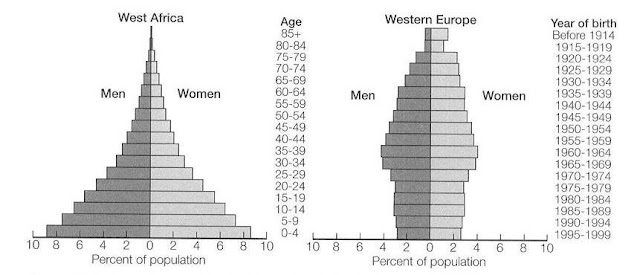"There is a strong tendency for countries with lower national IQ scores to have higher fertility rates and for countries with higher national IQ scores to have lower fertility rates."[21] _Wiki
A world map showing countries by fertility rate. Period 2005-2010
7-8 Hijos / Children
6-7 Hijos / Children
5-6 Hijos / Children
4-5 Hijos / Children
3-4 Hijos / Children
2-3 Hijos / Children
0-2 Hijos / Children
Source: Swivel
Source: CIA World Factbook - Unless otherwise noted, information in this page is accurate as of January 1, 2009
The TFR can be used as an estimate of the fertility growth factor in a population, e.g., whether the childbearing population is replacing itself or not. A TFR of 2,000 or above indicates that, on the average, couples are producing at least two children to replace themselves. When the TFR exceeds 2,000 for an extended period, the next generation of childbearing age will probably be larger than the present population of that age if all other factors affecting the population, such as death rates and migration, remain constant. Pennsylvania's TFR has been under 2,000 since 1972. However, it has remained relatively stable since then, although still below replacement level. The TFR is not meant to be used as an absolute measure of population trends, but can be helpful in understanding and analyzing them. There are many other factors to consider when determining population trends, such as crude birth rates, death rates and migration patterns. In fact, it would take several generations of a childbearing population maintaining a replacement level to just stabilize a specific population, again given that other factors, mainly age-specific death rates, were also maintained.
To obtain the 1996 TFR for Pennsylvania, compute the following:
| Age of Mother | Number of Live Births | Female Population | Age-Specific Rate | ||||
| 10-14 | 367 | / | 387,341 | x | 1000 | = | 0.9 |
| 15-19 | 15,267 | / | 408,422 | x | 1000 | = | 37.4 |
| 20-24 | 30,613 | / | 403,191 | x | 1000 | = | 75.9 |
| 25-29 | 42,245 | / | 397,398 | x | 1000 | = | 106.3 |
| 30-34 | 39,105 | / | 446,488 | x | 1000 | = | 87.6 |
| 35-39 | 17,378 | / | 469,810 | x | 1000 | = | 37.0 |
| 40-44 | 2,808 | / | 458,439 | x | 1000 | = | 6.1 |
| 45-49 | 94 | / | 413,377 | x | 1000 | = | 0.2 |
| Sum | 351.4 |
The TFR is the sum of the age-specific birth rates multiplied by five or (351.4 x 5 = 1757.0).



2 comments:
The population percentage of Africa seems to be a more robust model of stability.
Natural systems grow from the bottom-up, with some net excess for compensation for disasters. Perhaps the problem with the modern world is that we have eliminated too many dangers, and thus, the need for more children. This has created a system dependent upon externalities for its sustenance that are not natural, such as oil to run all of the systems that keep people alive when they otherwise would have died. The oil consumption rates should be somehow applied to these charts to show what keeps the population of various countries in the state they are in (high IQ, low death rates, poor immune systems, high diabetes rates). In other words, we don't need high IQ's, we need useful people who are healthy doing work that is useful to the future generations. The current numbers don't mean anything to the future unless they correlate to consumption of resources that are critical to future generations. Going by your info, then, net future usefulness is inversely proportional to IQ.
Fertility rates are useful indicators but they are not able to measure change. They are a 35 years mean (FR are computed for all the women between 15 to 50).
Saudi Arabia is show to have an high fertility rate, but what is not show is that this fertility rate is free falling from the 1980.
As the old cohorts fall out and the new fall in, the number is changing fast.
If the mathematics is not an opinion and the mean is what is supposed to be, the Saudis had a large delay in childbearing from the 1980. I suppose the public schooling of the females delayed the first child for a few years. Then the population growth (near doubling) have halved the per capita income. This have reduced the number of children a family can rear. The population started to move in cities and there the children are a financial drain more than an asset. It is difficult to have many children if you must live in a small apartment of 80 m2 or less. One, two, no more.
The reducing, per capita, income caused and will cause the negative feedback to the fertility to continue. The lack of investment money have forced them to stop to support agriculture in the desert, so they have more people without jobs and the need to import more food. Saudi Arabia will fade away, like all the Arab world (and Islam) as soon as the oil revenues will not be enough to support the governments and their political agenda.
Africa is a basket case. The rapid growth will prepare a big crunch of some type. War, chaos and famine will hit hard if they don't adapt fast. Some will, many will not..
Post a Comment